Recent Images
Most recent are at the top, click on any image to see larger version
OIII-thumb.jpg)
Jun-2009
The Pelican Nebula in Cygnus
Telescope: Pentax 75 SDHF APO Refractor
Camera: ATIK 314L
Moonlight means I switch to using narrow-band filters. This is an image with 2 hours each of data from Ha and OIII filters. I am trying to grab the missing SII data but no clear nights so far! However, I processed this image by synthesizing a 'green' channel by a 50/50 combination of the Ha and OIII channels. Then the Ha was assigned to the red and the OIII to the blue channel. I am very pleased with this and will be able to produce an image in the 'Hubble palette' once I get the missing SII data.
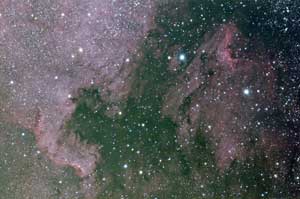
31-May-2009
The North American and Pelcan Nebulae in Cygnus
Telescope: Pentax 75 SDHF APO Refractor (first-light image!)
Camera: QHY8 one-shot colour
Now using the superb little Pentax 75mm triplet APO, and this is the first-light image with this scope. Very pleased with the performance of the Pentax and the QHY8 camera. 6 x 20 min exposures in here, and this is the first time I have auto-guided 20 minute exposures with round stars! I would have added more but at this time of the year in the UK it is only dark from midnight until just after 2am.
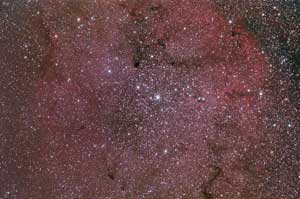
22-May-2009
IC1396 in Cepheus
Telescope: 80mm semi-APO ED80 refractor
Camera: QHY8 one-shot colour (first light image!)
The 'first-light' image with my new QHY8 cooled single-shot colour camera. 5 x 15 min exposures were combined to make this shot. Note that vbd142 can be seen center-right in this image and you can compare the scale with the image of vdb142 near the bottom of this page. This shows the difference between the sizes of the CCD chips in the QHY8 compared to the smaller ATIK 314L.
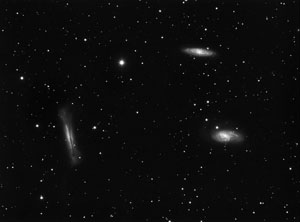
Apr-2009
The Leo Triplet of Galaxies (work in progress)
Telescope: 80mm semi-APO ED80 refractor with 0.67x telecompressor
Camera: ATIK 314L
A luminance-only shot of the famous triplet of Galaxies in Leo. I will shortly be adding the colour data to this image.
The detail in these galaxies is nice and sharp due to the steady seeing conditions prevailing at the time.
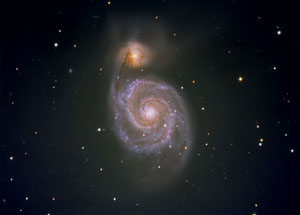
Mar-2009
The Whirlpool Galaxy M51 in Canes Venatici
Telescope: Vixen VC200L with 0.67x telecompressor
Camera: ATIK 314L
This is a very famous galaxy called M51 or the Whirlpool Galaxy in the constellation of Canes Venatici (The Hunting Dogs, just off the ‘handle’ of the plough). Actually there are two galaxies, the top one passed through the main disk of the bigger one about 500 million years ago and pulled out the trail that now links the two together. This Galaxy is also famous because Lord Rosse first observed the spiral structure in 1845 using the legendary 72-inch telescope at Birr Castle in Ireland.
The galaxies are about 24,000,000 light years away and contain about 160,000,000,000 stars.

Mar-2009
Bode's Galaxy M81 in Ursa Major
Telescope: Vixen VC200L with 0.67x telecompressor
Camera: ATIK 314L
A closer, high-resolution shot of M81.
Thanks to Eddie Guscott for assistance in processing this image.
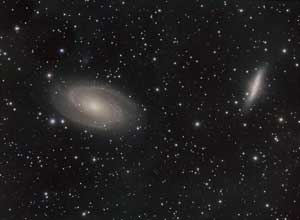
Jan-2009
Galaxies M81 and M82 in Ursa Major
Telescope: 80mm semi-APO ED80 refractor
Camera: ATIK 314L
A beautiful pair of Galaxies called M81 and M82 in the constellation of Ursa Major (The Plough or Great Bear). The biggest one, M81, is also known as Bode’s Galaxy. The smaller one is very interesting in that it is known as a ‘starburst’ galaxy. There are groups of energetic young stars being born in the center at an amazing rate making it look like it is exploding.
The fuzzy mass above M81 is a dwarf partner galaxy called Holmberg IX, it is very faint and most amateur images of this galaxy do not pick it up. The general misty nebula pervading the whole image is even harder to record and is part of the ‘Integrated Flux Nebula’ which is part of our own Milky Way Galaxy and much closer to us than the other Galaxies which are about 12 million light-years distant.
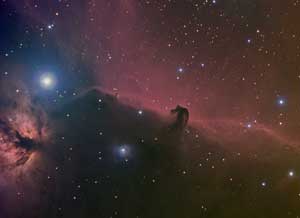
17-Oct-2008
The Horse Head Nebula in Orion
Telescope: 80mm semi-APO ED80 refractor
Camera: ATIK 314L
The Horsehead Nebula, a part of the optical nebula IC434 and also known as Barnard 33, was first recorded in 1888 on a photographic plate taken at the Harvard College Observatory. Its coincidental appearance as the profile of a horse's head and neck has led to its becoming one of the most familiar astronomical objects. It is found close to the lowest star in the belt of Orion called Alnitak.

27-Sep-2008
Spiral Galaxy in Triangulum (M33)
Telescope: 80mm semi-APO ED80 refractor
Camera: ATIK 314L
This galaxy is a member of 'our' Local Group of galaxies and is a bit over 3,000,000 light-years away. The pronounced spiral arms exhibit numerous reddish HII regions (including NGC 604), as well as blueish clouds of young stars.
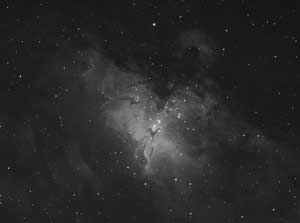
Nov-2008
The Eagle Nebula (M16) in Serpens Cauda
Telescope: 80mm semi-APO ED80 refractor
Camera: ATIK 314L
I took this image as a warm up to a night's observing and didn't really expect much from it due to the very low altitude at the time. Also, the sky was very brightly moon-lit and not completely dark at the time. This shows the power of using a narrowband H-Alpha filter which just doesn't 'notice' moonlight.
The bright 'fingers' seen near the center have been made famous by the amazing Hubble Space Telescope images of the same area known as 'The Pillars of Creation'.
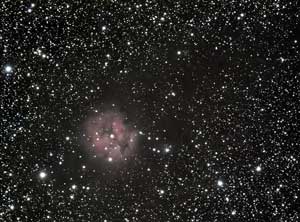
26-Sep-2008
The Cocoon Nebula in Cygnus (IC 5146)
Telescope: 80mm semi-APO ED80 refractor
Camera: ATIK 314L
This is a nebulous region and open star cluster in the north-eastern part of Cygnus, comprising a combination of emission and reflection nebulae. The nebula lies at a distance of about 4000 light-years.
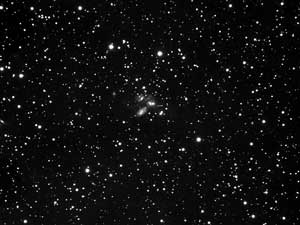
25-Sep-2008
Stephan's Quintet
Stephan's Quintet, as its name implies, is a group of five galaxies (NGC7317, 7318A, 7318B, 7319 and 7320) in the constellation Pegasus. Although the lowest one (NGC7320) appears to be part of the group, it's redshift indicates that it is closer that the other four. The main group of four are about 300 million light-years distant. Although small on this image, it is sobering to think that these galaxies show up well here considering a small 3-inch refractor was used.
This image is monochrome because all the exposures were taken using an Astronomik Type2c Luminance filter - no colour filters have been used (yet!)
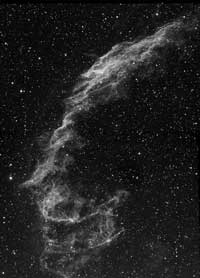
22-Sep-2008
The Eastern Veil Nebula in Cygnus
Telescope: 80mm semi-APO ED80 refractor
Camera: ATIK 314L
The Veil Nebula, also known as the Cygnus Loop is a large, supernova remnant in the constellation Cygnus. The full loop covers an area in the sky about 3 degrees acron (the full moon is about half a degree across). The Eastern part of the Veil shown here forms part of the curve of the whole loop. The supernova which generated this nebula exploded some 5,000 to 8,000 years ago.
This image is a montage of two images taken over several nights. So far, only a H-alpha filter has been used which is why this image is monochome. Over the next few weeks (clear nights permitting) I hope to capture O-III and RGB data to combine into a full colour image.
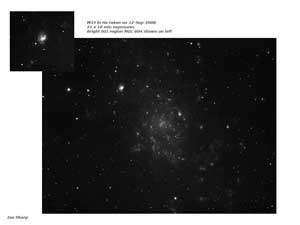
18-Sep-2008
Bright HII Region NGC604 in M33
Telescope: 80mm semi-APO ED80 refractor
Camera: ATIK 314L
Taking images of M33 with a H-alpha filter reveals the bright HII emission nebulae with the spiral arms of the M33 galaxy. This image shows a small inset of the brightest and biggest HII region called NGC604. A fair amount of structure can be seen even using this small 3-inch refractor.
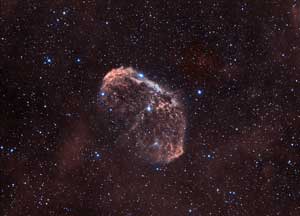
14-Sep-2008
The Crescent Nebula in Cygnus (NGC6888)
Telescope: 80mm semi-APO ED80 refractor
Camera: ATIK 314L
This is an emission nebula and lies about 5000 light years away. It is formed by the fast stellar wind from the causing star colliding with and exciting the slower moving wind ejected by the same star when it became a red giant around 400,000 years ago. The result of the collision is a shell and two shock waves, one moving outward and one moving inward.
This false-colour image is a combination of exposures taken with H-alpha and O-III filters. I used the H-a as the red channel and the OIII as the blue and created a green channel by combining them both.
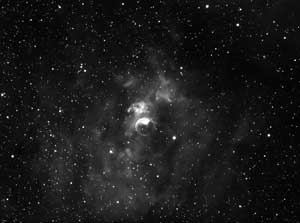
15-Jul-2008
The Bubble Nebula in Cassiopeia (NGC7635)
Telescope: 80mm semi-APO ED80 refractor
Camera: ATIK 314L
This strange object is an H-II region emission nebula. The bubble is created by the stellar wind from a massive hot, young central star, The nebula is near a giant molecular cloud which contains the expansion of the bubble nebula while itself being excited by the hot central star, causing it to glow. The bubble is about 10 light-years across and lies about 7000 light-years away.
So far, only a H-alpha filter has been used which is why this image is monochome, more clear nights are needed to capture the RGB colour data.
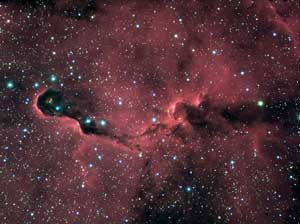
03-Jul-2008
The Elephant's Trunk Nebula in Cepheus (vdb142)
Telescope: 80mm semi-APO ED80 refractor
Camera: ATIK 314L
vdB142 is the small reflection nebula in the elephant's trunk, which is itself only a small part of the huge emission nebula/star cluster called IC1396 in Cepheus. O and B type stars in the cluster create the elephant trunk when their stellar winds hit denser, dark star forming regions. The shock front of the collision lights up brightly in the characteristic pink color of hydrogen alpha light.
This image was taken using Ha and RGB filters. The Ha and the red were combined to produce the Luminance channel. Total exposure is about 8 hours.
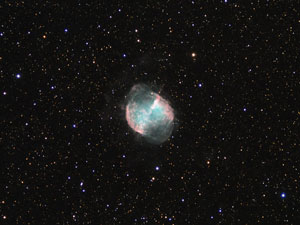
25-Jun-2008
The Dumbbell Nebula in Vulpecula (M27)
Telescope: 80mm semi-APO ED80 refractor
Camera: ATIK 314L
This famous planetary nebula is the type of nebula our Sun will produce when nuclear fusion stops in its core. Don't worry, that won't happen for another 5,000 million years! A white dwarf star lies at the center, the nebula is formed from the outer parts of the star when they were blown off into space. This object is about 1360 light-years away.
This image was my first attempt a using my ATIK 314L camera with seperate filters. I am not too happy with the colour in this image and will be re-processing it soon.